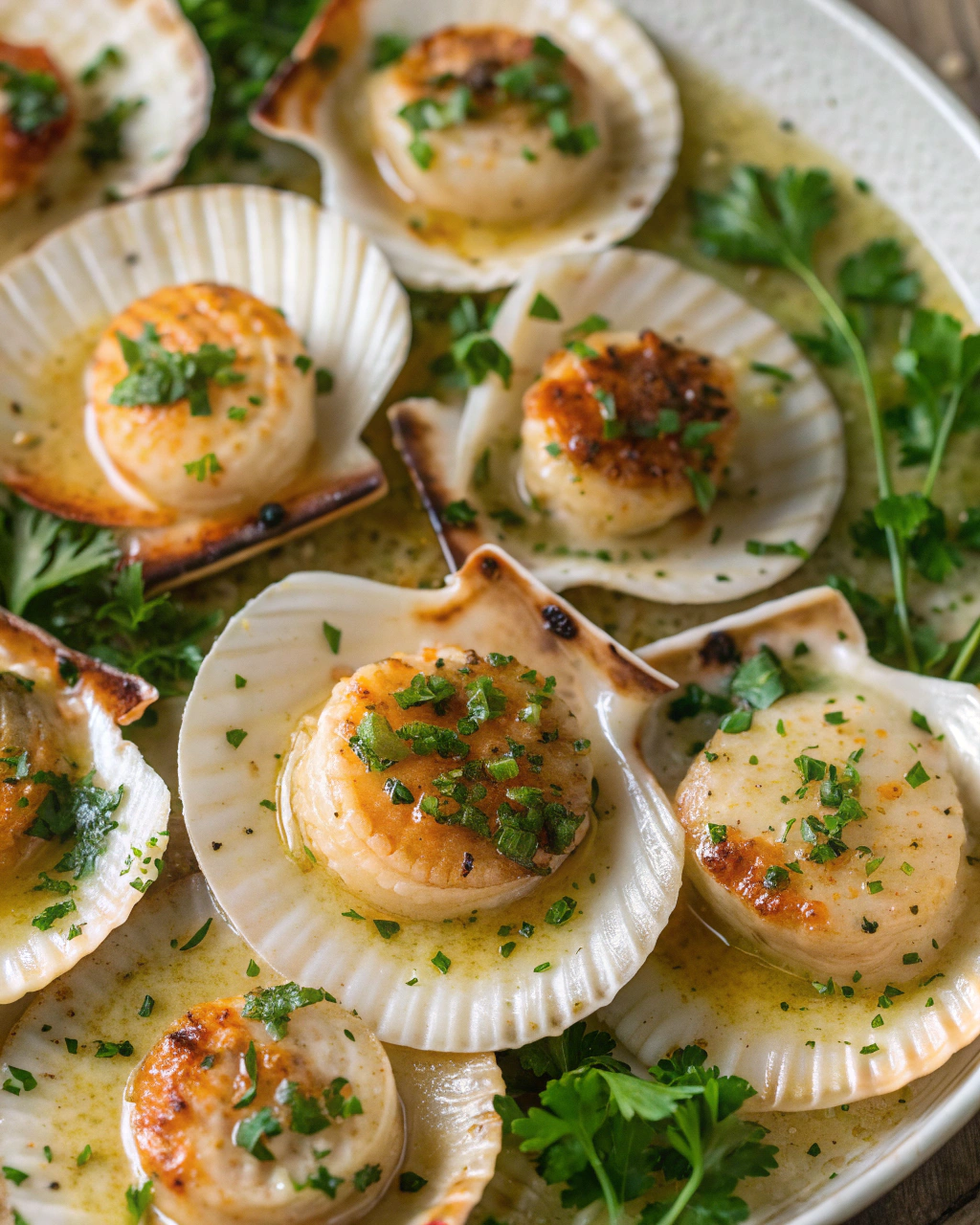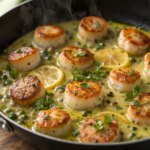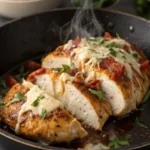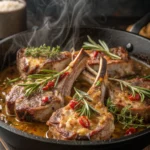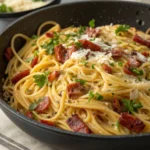Okay, lean in—I’ll let you in on a little chef’s secret I stole from a busy bistro nights ago: the difference between “good scallops” and “jaw-dropping scallops” lives in the butter and timing. I learned to get that glassy, golden crust by heating the pan to the exact right roar and finishing with garlic and fresh parsley so the whole kitchen smells like a seaside bistro. This recipe gives you that restaurant-level sizzle with home-kitchen ease. Follow my timing cues, keep your scallops dry, and I promise you a plate that looks fancier than it costs or takes.
Quick Facts
- Yield: Serves 2
- Prep Time: 10 minutes
- Cook Time: 6–8 minutes
- Total Time: 16–18 minutes
Why This Recipe is Awesome
This dish gets to the point: sweet, tender sea scallops with a nutty, golden crust and an ultra-fragrant garlic butter finish. It smells like comfort and celebration at once—garlic, brown butter, bright parsley. Texture plays lead: a crisp exterior that gives way to a pillowy center. It’s so simple even your weeknight self will feel fancy. And yes, it makes the house smell incredible—your neighbors might drop by.
Ingredients
For the Main Dish:
- 1 pound dry sea scallops (small to medium; about 8–12 scallops)
- 2 tbsp oil (canola or grapeseed)
- 3 tbsp unsalted butter
- 3 cloves garlic, finely minced
- 1 tbsp fresh lemon juice (about half a lemon)
- 2 tbsp fresh parsley, finely chopped
- Kosher salt and freshly ground black pepper, to taste
- Optional: pinch of red pepper flakes for heat
For the Sauce / Garnish (if applicable):
- 1 tbsp cold butter (to finish, optional for gloss)
- Lemon wedges for serving
How I Make It
Step 1:
Start by patting the scallops very dry with paper towels—this step matters more than you think. Season both sides with a light dusting of kosher salt and pepper. Heat a large skillet over medium-high heat until it feels hot (you want it to sizzle when a drop of water hits). Add 2 tbsp oil and let it shimmer—this gives the scallops that immediate, audible sizzle.
Step 2:
Carefully place the scallops in the pan, leaving space between each one. You should hear a satisfying sizzle. Cook without moving them for 1½–2 minutes until the edges turn opaque and you see a deep golden crust form. Flip each scallop and continue cooking for another 1½–2 minutes.
Step 3:
Lower the heat to medium, push the scallops to the side, and add 3 tbsp butter to the pan. Let the butter foam and start to brown slightly—watch closely and catch that nutty aroma. Add the minced garlic and a pinch of red pepper flakes if you like heat; stir for about 20–30 seconds until fragrant (don’t burn it). Tilt the pan and spoon the garlic butter over the scallops for glossy flavor.
Step 4:
Finish with 1 tbsp lemon juice and most of the parsley, reserving a little for garnish. Taste and adjust seasoning—add an extra pinch of salt if needed. Look for a golden crust and an opaque center; scallops should feel springy and slightly firm when done. If you want to keep them warm while finishing sides, place the skillet in a 200°F oven for a few minutes.
Step 5:
Plate the scallops, spoon the remaining buttery sauce over the top, scatter the reserved parsley, and add lemon wedges. If you like a silky finish, drop in the optional 1 tbsp cold butter and swirl until it melts into the sauce. Serve immediately and enjoy the applause (or at least very satisfied plate scraping).
Pro Tips
- Buy dry scallops (no sodium tripolyphosphate). They sear better and taste cleaner.
- Pat scallops completely dry. Moisture kills the crust—use paper towels and give them 5 minutes to air-dry if needed.
- Don’t overcrowd the pan. Cook in batches so each scallop gets direct contact with the hot surface.
- Watch the butter carefully during browning—once it smells nutty, act fast. Burned butter tastes bitter.
Common Mistakes to Avoid
- Skipping preheating: Classic rookie move. It changes texture and bake time.
- Overmixing: Leads to dense or chewy results. Mix until just combined.
- Guessing cook time: Always use visual cues or a timer, not just vibes.
- Overcrowding pans: Give your food some breathing room to crisp properly.
Alternatives & Substitutions
- If you can’t find scallops, use large shrimp—cook 2–3 minutes per side until pink. Texture changes but flavor stays bright.
- Swap unsalted butter for ghee for a slightly nuttier taste and higher smoke point.
- For dairy-free, use 2 tbsp high-heat oil + 1 tbsp melted coconut or vegan butter at the end for richness; this keeps things gluten-free too.
- Want lower fat? Use 1 tbsp oil and 1 tbsp butter—still delicious, slightly lighter.
Variations & Tips
- Spicy: Add ½ tsp smoked paprika and a pinch of cayenne to the scallops before searing.
- Herby: Swap parsley for basil or tarragon for a fresh twist.
- Kid-friendly: Omit red pepper flakes and serve with a lemon-butter sauce on the side.
- Creamy: Finish with 2 tbsp heavy cream for a richer pan sauce—serve over rice or pasta.
- Surf & Turf: Pair with quickly pan-seared steak tips for a date-night plate.
- Creative twist: Add a splash of dry white wine (2 tbsp) when deglazing before adding lemon—to make a slightly tangy pan sauce.
FAQ (Frequently Asked Questions)
- Can I make this ahead of time?
- Yes! You can prep scallops by patting them dry and seasoning them up to 24 hours ahead, stored covered in the fridge. Sear just before serving for best texture. Reheat gently in a hot skillet for no more than 1 minute per side to avoid overcooking.
- Can I double the recipe?
- Sure thing. Sear in batches so you don’t overcrowd the pan; keep cooked scallops warm in a 200°F oven while you finish the rest.
- Can I substitute butter with oil?
- Technically yes, but you’ll miss that buttery magic. Use ¾ the amount of oil and finish with a small pat of butter or a dairy-free buttery alternative for gloss.
- How do I know it’s done?
- Look for a deep golden crust and an opaque center. Scallops should feel slightly springy and firm—not mushy. The FDA recommends cooking seafood to 145°F, but with scallops I rely on the visual and textural cues.
- What if I don’t have ingredient X?
- No lemon? Use a splash of white wine or a teaspoon of apple cider vinegar. No parsley? Try chives or basil for a fresh finish.
How I Like to Serve It
I love serving these scallops over a bed of buttery mashed potatoes or creamy polenta so each bite gets saucy goodness. They also shine on a simple arugula salad with a lemon vinaigrette for a lighter meal. Pair with a chilled glass of Sauvignon Blanc or a crisp lager. This dish fits weeknight romance, a quick dinner party, or when you want to impress without sweating it.
Notes
- Store leftovers in an airtight container in the fridge for up to 2 days. Reheat briefly in a hot skillet—don’t microwave, or they’ll get rubbery.
- Seafood safe cooking temp: aim for 145°F internal or use visual cues (opaque, firm) to avoid under- or overcooking.
Final Thoughts
Closing: Now go impress someone — or just yourself — with your homemade masterpiece!

Hi, I’m Lina, the creator of Lina Easy Recipes.Cooking has always been my passion, and I love sharing simple, homemade dishes that anyone can prepare.
Love What You See?
Join me on Pinterest and Facebook for daily cooking inspiration, new recipe ideas, and behind-the-scenes kitchen stories. Let’s cook something wonderful together!

